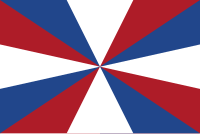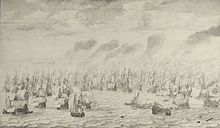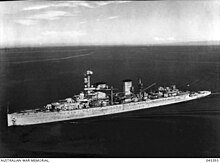Royal Netherlands Navy
| Royal Netherlands Navy Koninklijke Marine | |
|---|---|
 Royal Netherlands Navy jack | |
| Founded | 1488 |
| Country | |
| Allegiance | Netherlands and NATO |
| Branch | Navy |
| Size | 10,000 personnel,
6 support ships |
| Headquarters | Den Helder |
| Engagements | Eighty Years' War Dutch-Portuguese War Anglo-Dutch Wars War of Spanish Succession War of the Quadruple Alliance World War II |
| Commanders | |
| Commandant Zeestrijdkrachten | Vice Admiral M.J.M. Borsboom |
| Vice-commander | Generaal Majoor der Mariniers T. van Ede, |
| Notable commanders | Michiel de Ruyter, Maarten Harpertszoon Tromp, Jan van Speyk, Karel Doorman |
The Koninklijke Marine (Royal Netherlands Navy) is the navy of the Netherlands.
Bases
The main naval base is Den Helder, Noord Holland. Secondary naval bases are in Amsterdam, Vlissingen, Texel and Willemstad (Curaçao). Marine barracks are in Rotterdam, Doorn, Suffisant on Curaçao, and Savaneta on Aruba.
Service academy
The Royal Netherlands Naval College is the service academy of the Royal Netherlands Navy.
History
Dutch Golden Age

The Dutch navy has a long history. It was involved in many wars against other European powers since the late 16th century, initially for independence against Spain in European waters, later for shipping lanes, trade and colonies in many parts of the world, notably in four Anglo-Dutch wars against England and the United Kingdom.
World War II

During the Second World War, the Dutch navy was based in Allied countries after the Netherlands were conquered by Nazi Germany in a matter of days: the Dutch navy had its headquarters in London and smaller dependencies in Sri Lanka and Australia.
Around the world Dutch naval units were responsible for troop transport, for example during Operation Dynamo in Dunkirk and D-Day, they escorted convoys and attacked enemy targets. During the war the navy suffered heavy losses, especially in defending the Dutch East Indies, most notably the Battle of the Java Sea in which the commander, Dutchman Karel Doorman, went down with his ships together with 1000 of his crew.
After the war, the relations between the Netherlands and its colonies changed dramatically. The establishment of the Republic of Indonesia, 2 days after the Japanese surrender, thwarted the Dutch plans for restoring colonial authority. It took 4 years of war before the Netherlands acknowledged the independence of Indonesia. The Dutch navy was stationed in Papua until it was turned over to the Indonesians in 1962, because the action from the Military of Indonesia, supported by the modern military equipments from Soviet Union, as the order of President Sukarno to integrate it into as one of Indonesian provinces.
NATO cooperation

With the creation of the North Atlantic Treaty Organisation, the military focus was on the army and air force; it was not until the Korean War (1950-1953) that the navy got more recognition. The government allowed the creation of a balanced fleet consisting of 2 naval squadrons. Apart from the aircraft carrier Hr. Ms. Karel Doorman the Dutch navy consisted of 2 cruisers (2 De Zeven Provinciën class), 12 destroyers (4 Holland class, 8 Friesland class), 8 submarines, 6 frigates (van Speijk class frigates) and a large number of minesweepers.
As a NATO member the Netherlands developed its security policy in close cooperation with other members. The establishment of the Warsaw pact in 1955 intensified the arms race between West and East. Technical innovations rapidly emerged, the introduction of radar and sonar were followed by nuclear weapon systems and long-range missiles. The geopolitical situation allowed for a fixed military strategy. From 1965 onwards the Netherlands joined certain permanent NATO squadrons like the Standing Naval Force Atlantic.
Current structure
The constituent parts of the Royal Netherlands Navy are:
Naval squadron
Contains all surface combatants, replenishment ships and amphibious support ships.
Submarine service
Contains the submarines and a support vessel.
Mine Detection and Clearing Service
Contains various minehunters.
Hydrographical Survey
Contains ships which map the oceans.
- 2 helicopter squadrons
- 1 Brigade (MTC: Mariniers Training Commando (formerly known as GOEM: Groep Operationele Eenheden Mariniers) consisting of 4 battalions
- 2 operational marine battalions (MARNSBAT1,2)
- 1 amphibious combat support battalion (AMFGEVSTBAT)
- 1 Amphibious Logistical battalion (AMFLOGBAT)
1 rifle company (32 Infcoy) is permanently stationed at Aruba
Coast Guard
Although the Coast Guard is not an official part of the Navy, it is under its operational control. Also the Netherlands Antilles & Aruba Coast Guard is under the operational control of the Navy and is commanded by the commander of the Navy in the Caribbean.
Equipment
The Royal Netherlands Navy currently operates 7 main classes of vessels:
| Class | Type | Number | Dates | Details |
|---|---|---|---|---|
| De Zeven Provinciën | Frigate* | 4 | 2002 | Mainly Anti-air warfare, ASh, ASW |
| Karel Doorman class | Frigate | 2 | 1994 | Multipurpose tasks |
| Zuiderkruis class | Replenishment | 1 | 1975 | Fleet support/replenishing (to be replaced in 2015) |
| Amsterdam class | Replenishment | 1 | 1995 | Fleet support/replenishing |
| Alkmaar class | Minehunter | 10 | 1989 | Minehunting/Minesweeping (combined) upgraded in 2009-2011 |
| Walrus class | Submarine | 4 | 1994 | Diesel-electric powered hunter-killer submarines for deep ocean operations |
| Rotterdam class | Landing Platform Dock | 2 | 1998/2007 | Troop & helicoper transport |
* The Dutch Royal Navy classifies the De Zeven Provinciën as frigates, but internationally they are most comparable to destroyers (due to their size and weapon capability)
The constituent Equipment of the Royal Netherlands Navy are:
Surface combatants
- 4 De Zeven Provinciën class air defence and command frigate (LCF, officially classified as frigates but in size and weaponry they could be classified as destroyers)
- 2 Karel Doorman class multi-Purpose-frigates (also known as M-class)
Amphibious assault ships
- 2 landing platform dock (LPD) / Amphibious Transport Ships
Submarines
- 4 S802 Walrus class Diesel/electric attack submarines. (currently being upgraded for operations well into the 21st Century)
Mine detection and clearing ships
- 10 Tripartite (Alkmaar class) mine hunters
3 to be converted to control vessels for mine-sweep drones, 14 of which will be acquired)
- 4 A851 Cerberus class diving support vessels.
Support ships
- 1 Zuiderkruis class replenishment Ship
- 1 Amsterdam class replenishment Ship
- 1 A900 Mercuur class Torpedo recovery ship
- 1 A804 Pelikaan logistic support vessel for the Netherlands Antilles (amphibious & diving operations and transport)
Hydrographical survey ships
- 2 A802 Snellius class hydrographical survey ship.
Training ships
- 1 A902 Van Kinsbergen class training ship
- 1 Y8050 Urania class sailing naval training vessel
Landingcraft (Marine Corps)
- 5 L9525 LCU Mk2 class landing craft utility
- L9525
- L9526
- L9527
- L9528
- L9529
All ships of the L9525 LCU class have been upgraded to Mk2. This upgrade meant enlarging the vessels and increasing their payload (enabling the craft to transport the Royal Netherlands Army's Leopard 2 A6).
- 6 L9536 LCVP Mk3 class landing craft vehicle personnel
- L9536 (out of commission Jan 2010)
- L9537
- L9538
- L9539 (out of commission Jan 2010)
- L9540
- L9541
- 6 L9530 LCVP Mk2 class landing craft vehicle personnel
- L9530
- L9531
- L9532
- L9533
- L9534
- L9535
The 12 LCVP's will be replaced by 12 LCVP Mk5c in 2009 & 2010, build by Visser Shipyard in Den Helder with improved handling & speed.
Other ships
- 5 A874 Linge class large tugs.
- HNLMS Linge (A874)
- HNLMS Regge (A875)
- HNLMS Hunze (A876)
- HNLMS Rotte (A877)
- HNLMS Gouwe (A878)
- 2 Y8018 Breezand class harbor tugs
- HNLMS Breezand (Y8018)
- HNLMS Bergzand (Y8019
- 5 Y8055 Schelde class harbor working boats
- HNLMS Schelde (Y8055)
- HNLMS Wierbalg (Y8055)
- HNLMS Malzwin (Y8055)
- HNLMS Zuidwal (Y8055)
- HNLMS Westwal (Y8055)
- 1 Y8536 Patria class inshore tanker
- HNLMS Patia (Y8536)
- 1 Y8005 Nieuwediep class touring boat
- HNLMS Nieuwediep (Y8005)
- 2 Y8200 harbor vessels
- Y8200
- Y8300
- 1 WM1-9002 Jonge Jan class harbor vessel
- Jonge Jan (WM1-9002)
- 1 WM1-9003 Jonge Prins 3 class harbor vessel
- Jonge Prins 3 (WM1-9003)
- 3 patrol cutters for the Netherlands Antilles (NAACGC Jaguar P810, NAACGC Panter P811 and NAACGC Poema P812)
Maritime helicopters
- 21 SH-14D Lynx anti-submarine warfare helicopters
- 20 NH-90 anti-submarine/surface warfare helicopters (being introduced)
Armored vehicles (Marine Corps)
- 106 BV206S armored all-terrain personnel carriers
- 74 BVS10 armored all-terrain personnel carriers
- 20 XA-188 wheeled armored personnel carriers(To be sold to Estonia and replaced by the newly bought Bushmaster)
- 4 Leopard 1 BARV beach armored recovery vehicles
Unarmored vehicles (Marine Corps)
- Land Rover Defender
- Unimog 1.2-ton truck
- Various DAF trucks
Artillery (Marine Corps)
- RT-120 (Habé Rayé) 120mm mortars
- L16A2 81mm mortar
Personal weapons
- Diemaco C7A1 5.56mm assault rifle
- Diemaco C8A1 5.56 mm carbine
- Diemaco C7 LSW light machinegun
- Glock 17 pistol
- FN MAG general purpose machinegun
- M2HB 12.7mm (.50cal) heavy machinegun
- SSG sniper rifle
- Accuracy International AWM sniper rifle in .338 Lapua Magnum
- M107 12.7mm sniper rifle
- MP5 submachine gun
- P90 submachine gun
- M590A1 shotgun
- AT4 anti-tank rocket
- Panzerfaust 3 anti-tank weapon
- Gill anti-tank missile
- FIM-92C Stinger man-portable surface to air missile
2012 future naval inventory
In 2012 the new fleet plan of the Royal Netherlands Navy will be completed, consisting of these ships:
| Class | Type | Number | Dates | Details |
|---|---|---|---|---|
| De Zeven Provinciën | Frigate | 4 | 2002 | Mainly Anti-air warfare, ASh, ASW |
| Karel Doorman class | Frigate | 2 | 1994 | Multipurpose tasks |
| Holland Class | Offshore Patrol Vessel | 4 | 2011 | Ocean patrols |
| Alkmaar class | Minehunter | 10 | 1989 | Minehunting/Minesweeping (combined) |
| Amsterdam class | Replenishment | 1 | 1995 | Fleet support/replenishing |
| Zuiderkruis class JSS | Joint Support Ship | 1 | 2014 | Combined Amphibious Operations/Seabased Helicopter Platform & Fleet support/replenishing |
| Rotterdam class | Landing Platform Dock | 2 | 1998/2007 | Troop & helicopter transport |
| Walrus class | Submarine | 4 | 1994 | Diesel-electric powered hunter-killer submarines for deep ocean operations |
The total tonnage will be approx. 140.000t. Next to these ships a lot of other smaller vessels remain in the navy like the Snellius class hydrographical survey vessels.
With these changes the Royal Netherlands Navy will have 10 large ocean going vessels ranging from medium/low to high combat action ships. The renewed Dutch Navy will be a green-water navy, having enough frigates and auxiliaries to operate far out at sea, while depending on land-based air support and with the large amphibious squadron they will have significant brown-water navy capabilities.
Future changes
- Purchase of 4 Large Offshore Patrol Vessels Holland Class. The Dutch Ministry of Defence announced recently that these vessels will enter service a year later than planned.
- Extensive upgrading of the 2 remaining F827 Karel Doorman class, new SEWACO systems and lay-out of the ships. After these upgrades the ships can last till 2020–2025
- Purchase of 20 NH-90 helicopters to replace the Lynx helicopters currently in use and integration of all maritime helicopter into the Dutch Defense Helicopter Command
- Purchase New joint support ship Zuiderkruis class JSS. The Dutch Ministry of Defence announced recently that this vessel will enter service in 2015 and be able to combine sea replenishment capabilities with the ability to act as a sea based platform in support of amphibious operations (incl. CH-47 & AH-64 Helicopters).
- Extensive upgrading for Walrus class Submarines including new Sonar, weapons upgrades and probably AIP system for near shore operations.
- Upgrading the Zeven Provinciën class LCF frigates Theatre Ballistic Missile Defense and considered SLCM integration.
- Increasing the size of the Royal Netherlands Marine Corps. Currently, several units of the Marine Corps are being reorganized.
Theater Ballistic Missile Defense
Together with the United States and several other NATO members, the Dutch Navy is testing and updating its ships for Tactical ballistic missile Defense capability. Although tests conducted concerning the capability of the APAR (Active Phased Array Radar) have been very successful, no decision has been made by the Dutch Government in purchasing SM-3 missiles - mainly because the SM-3 is not operational yet. Four ships are being fitted out for Tactical ballistic Missile Defense. If purchased (after US export approval) the four LCFs will be fitted out with only eight SM-3 missiles each, due to the high costs for each missile (approximately $2.5 - $5 million).
Decommissioned ships
- 10 Kortenaer class, (1979-2003) - 8 sold to Greece, 2 sold to UAE
- 2 Jacob van Heemskerck class, (1986-2005) - 2 sold to Chile
- 6 of 8 Karel Doorman class, (1991-2008) - 2 each sold to Chile, Belgium and Portugal
- 2 Tromp class, (1974-2000) - 2 scrapped
- 1 Colossus-class aircraft carrier, Karel Doorman (1948-1969) Sold to Argentina
Historic ships
- Hr.Ms Buffel
- Hr.Ms. Abraham Crijnssen
- Hr.Ms. De Ruyter
- Hr.Ms. Jacob van Heemskerk
- Hr.Ms. Kortenaer
- Hr.Ms. Java
- Hr.Ms. Tromp
- Hr.Ms. Bonaire
- Hr.Ms. Schorpioen
- Hr.Ms. Johan Maurits van Nassau
- De Delft (1783-1797) 18th century ship of the line. Reconstructed in Rotterdam (Delfshaven)
- De Zeven Provinciën (1665-1694), 17th century ship of the line and flagship of Michiel de Ruyter currently being reconstructed at the Bataviawharf
- Submarines:
See also
- Dutch Naval Aviation
- Ships of the Royal Netherlands Navy
- Military history of the Netherlands
- Military ranks of the Dutch armed forces
